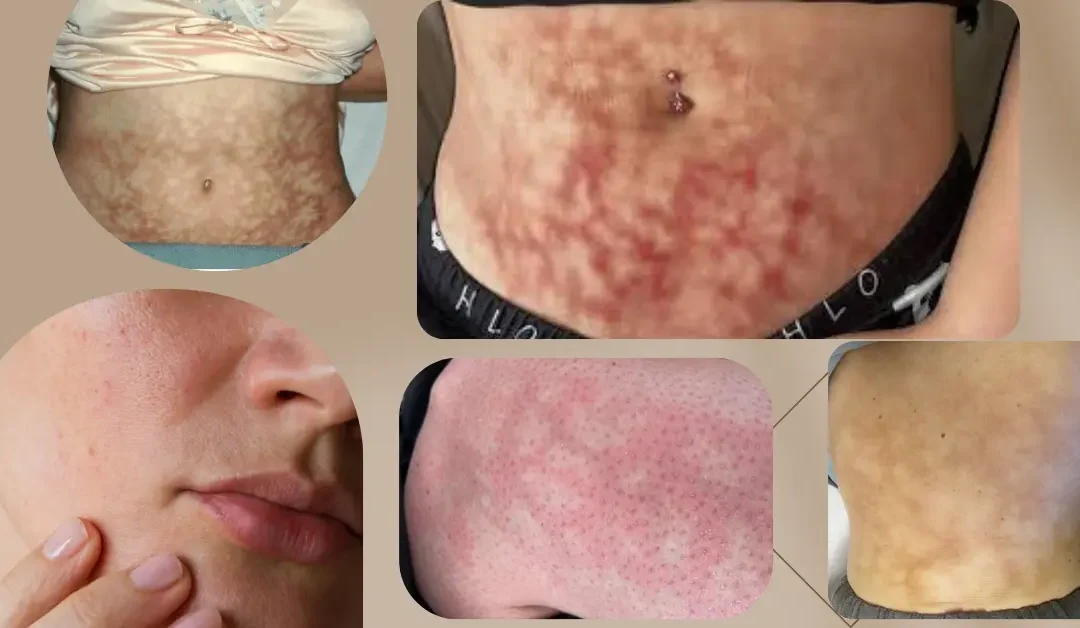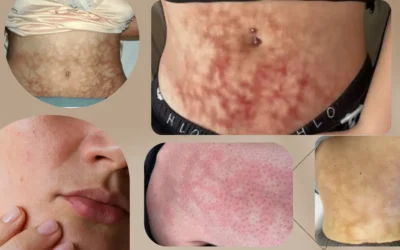Toasted Skin Syndrome (TSS), or Erythema Ab Igne, is a skin condition caused by prolonged exposure to moderate heat sources, such as heating pads, space heaters, and laptops.
It presents as a net-like, reddish-brown skin discoloration and, if left untreated, can become permanent. While severe cases may require medical intervention, most mild to moderate cases of TSS can be treated at home with proper care and skincare techniques.
In this guide, we’ll explore effective home remedies to soothe irritation, fade discoloration, and restore healthy skin.
Step 1: Eliminate Heat Exposure
The first and most important step in treating TSS at home is to immediately stop exposing your skin to the heat source responsible for the condition. Continued exposure will worsen pigmentation and increase the risk of permanent damage.
If you use heating pads for pain relief, consider switching to alternative methods such as warm compresses wrapped in a cloth or non-heat-based pain relief solutions.
Step 2: Keep the Skin Moisturized
Keeping the skin well-hydrated is essential for healing Toasted Skin Syndrome effectively. Using a gentle, fragrance-free moisturizer not only prevents dryness and irritation but also supports the skin’s natural repair process.
Opt for moisturizers rich in Aloe Vera, which soothes inflammation and aids in regenerating damaged skin. Ceramides help restore and strengthen the skin barrier while locking in moisture to prevent further dehydration.
Hyaluronic Acid is another powerful ingredient that provides deep hydration, ensuring the skin remains plump and elastic.
Additionally, Shea Butter and Coconut Oil serve as natural emollients, softening and nourishing the skin while reducing irritation. Applying a hydrating moisturizer consistently can significantly speed up recovery and improve skin texture over time.
Step 3: Use Skin-Brightening Treatments
To reduce pigmentation and fade the discoloration caused by TSS, consider incorporating the following ingredients into your skincare routine:
-
Vitamin C Serum – A potent antioxidant that brightens skin and helps fade hyperpigmentation.
-
Niacinamide (Vitamin B3) – Reduces redness and improves skin tone.
-
Licorice Extract – A natural skin lightener that can help fade dark patches.
-
Turmeric Paste – A natural remedy known for its anti-inflammatory and brightening properties.
Apply these treatments consistently, but be patient, as it can take several weeks to see visible improvement.
Step 4: Gentle Exfoliation for Skin Renewal
Exfoliation helps remove dead skin cells and promotes new cell turnover. However, since TSS can make the skin sensitive, it’s important to use gentle exfoliants.
-
Mild Chemical Exfoliants: Opt for products with glycolic acid, lactic acid, or mandelic acid, which help fade pigmentation without being too harsh.
-
Natural Exfoliants: A homemade oatmeal scrub or yogurt mask can provide gentle exfoliation while nourishing the skin.
-
Avoid Harsh Scrubs: Physical exfoliators with large particles can cause irritation and worsen the condition.
Step 5: Sun Protection is Essential
Exposure to UV rays can worsen TSS pigmentation and delay the healing process. Apply a broad-spectrum sunscreen with SPF 30 or higher daily, even if you’re indoors, as UV rays can penetrate windows.
For extra protection, wear clothing that covers the affected area and avoid prolonged sun exposure.
Step 6: Natural Home Remedies for Healing
Several natural remedies can help soothe irritated skin and promote healing:
-
Aloe Vera Gel: Known for its cooling and healing properties, aloe vera can reduce inflammation and promote skin repair.
-
Green Tea Extract: Contains antioxidants that help fade hyperpigmentation and calm irritated skin.
-
Honey: A natural humectant with antibacterial properties that can keep the skin moisturized and promote healing.
-
Potato Juice: Contains natural bleaching agents that can help lighten pigmentation over time.
Step 7: Maintain a Healthy Diet for Skin Repair
A nutrient-rich diet plays a crucial role in repairing and regenerating skin affected by TSS. Consuming foods packed with essential vitamins, antioxidants, and healthy fats can accelerate the healing process and restore skin health.
Incorporate Vitamin A and C (found in citrus fruits, carrots, sweet potatoes, bell peppers, and leafy greens) to support collagen production and enhance skin cell turnover.
Antioxidants (such as those found in berries, green tea, and dark chocolate) help neutralize free radicals, preventing further skin damage and reducing inflammation.
Healthy fats (from sources like avocados, nuts, seeds, and fatty fish) strengthen the skin barrier, improve elasticity, and keep the skin supple. Additionally, maintaining adequate hydration by drinking plenty of water and consuming water-rich foods like cucumbers, watermelon, and celery helps flush out toxins and keeps the skin moisturized from within.
Prioritizing a well-balanced diet can significantly improve the skin’s ability to recover and reduce the risk of permanent discoloration.
Step 8: Be Patient and Consistent
Healing from TSS takes time, and results may not be immediate. Consistency in following these home remedies and skincare tips is key.
If you don’t see improvement after a few months or notice worsening symptoms, it’s best to consult a dermatologist for professional treatments such as laser therapy or prescription creams.
Conclusion
Toasted Skin Syndrome can be effectively treated at home if caught early. Eliminating heat exposure, keeping the skin hydrated, using brightening agents, and protecting against UV rays are crucial steps in the healing process.
By following these simple yet effective remedies, you can help restore your skin’s health and reduce the appearance of discoloration over time. If symptoms persist, seeking medical advice is recommended to prevent long-term damage.


